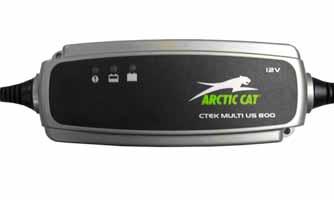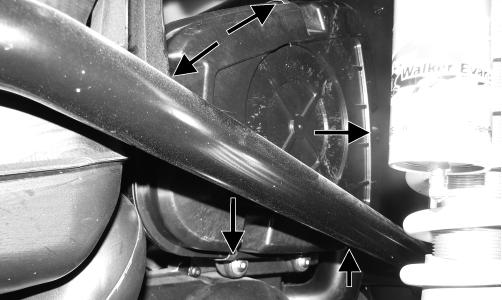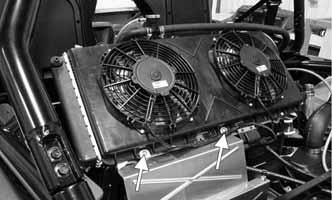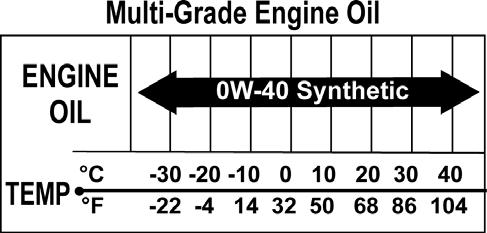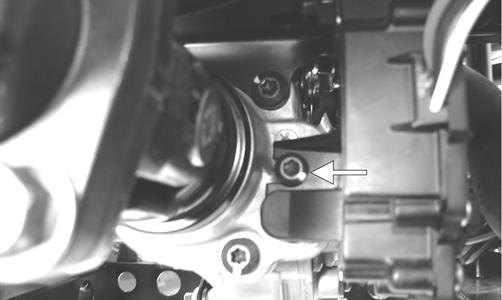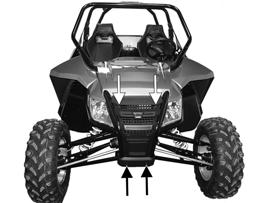
10 minute read
Suspension
The following suspension system components should be inspected periodically to ensure proper operation.
A.Shock absorber rods bent, pitted, or damaged.
B.Reservoirs damp or leaking.
C.Shock absorber body damaged, punctured, or leaking.
D.Shock absorber eyelets broken, bent, or cracked.
E.Shock absorber eyelet bushings worn, deteriorated, cracked, or missing.
F.Shock absorber spring broken or sagging.
G.Sway bar mountings tight and bushings secure.
H.Proper pre-load and damping for conditions.
Shock Absorbers
REMOVING 1.Secure the vehicle on a support stand to elevate the wheels and to release load on the suspension. 2.Remove the two cap screws and nuts securing each front shock absorber to the frame and lower A-arm.
Account for bushings and sleeves from each. 3.Remove the two cap screws and nuts securing each rear shock absorber to the frame and lower trailing arm. Account for bushings and sleeves from each. 4.Completely remove pre-load by turning the adjusters to the end of the threads and removing the retainer; then remove the spring. CLEANING AND INSPECTING 1.Clean all shock absorber components in parts-cleaning solvent. 2.Inspect each shock rod for nicks, pits, rust, bends, and oily residue. 3.Inspect all springs, spring retainers, shock rods, sleeves, bushings, shock bodies, and eyelets for cracks, leaks, and bends. INSTALLING 1.Place the shock absorber spring over the shock absorber, compress the spring, and install the retainer. 2.Place bushings and sleeves (where appropriate) into shock eyelet; then install shocks with two cap screws and nuts. 3.Tighten the front shock absorber cap screws to 40 ft-lb (head side) and rear shock absorber cap screws to 40 ft-lb (upper) and 35 ft-lb (lower). 4.Remove the vehicle from the support stand.
Front A-Arms
REMOVING 1.Secure the vehicle on a support stand to elevate the front wheels; then remove the wheels and account for the hub plate. NOTE: The upper A-arms can be removed without
removing the hub or knuckle. If the technician’s objective is to remove the upper A-arms, proceed to step 6.
WC240B
2.Remove the hub nut and Belleville washer securing the hub.
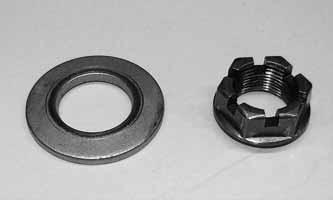
WC304
3.Remove the brake caliper. Account for two E-clips and two anchor bolts.
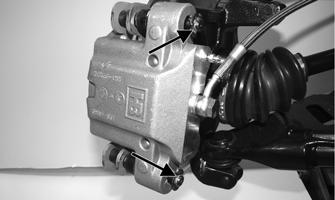
WC611A
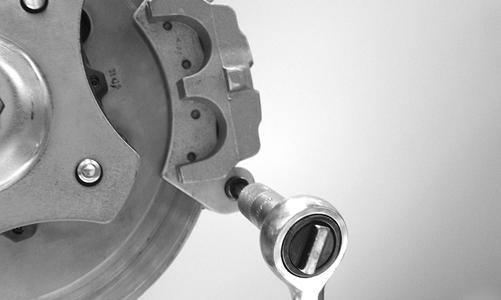
WC606
4.Remove the hub assembly. Account for the washer. 5.Remove the cotter pin and nut securing the tie rod end to the knuckle; then remove the tie rod end from the knuckle. 6.Remove and discard the cap screws securing the ball joints to the knuckle.
CAUTION
Support the knuckle when removing the cap screws or damage to the threads will occur.
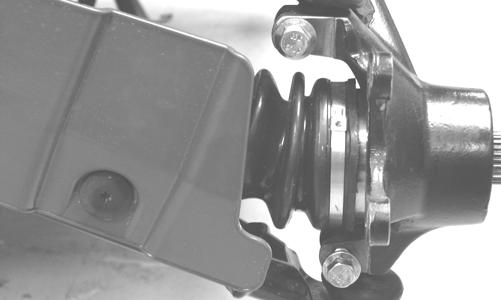
PR193
7.Tap the ball joints out of the knuckle; then remove the knuckle. 8.Remove the lower shock absorber eyelet from the lower A-arm. 9.Remove the brakeline hose routing clips from the upper A-arm; then remove the cap screws securing the
A-arms to the frame. CLEANING AND INSPECTING 1.Clean all A-arm components in parts-cleaning solvent. 2.Clean the ball joint mounting hole of all residual Loctite, grease, oil, or dirt for installing purposes. 3.Inspect the A-arm for bends, cracks, and worn bushings. 4.Inspect the ball joint mounting holes for cracks or damage. 5.Inspect the frame mounts for signs of damage, wear, or weldment damage. INSTALLING 1.Apply Loctite Primer “T” to the A-arm socket; then apply green Loctite #609 to the entire outside diameter of the ball joint. Install the ball joint into the A-arm and secure with the snap ring.
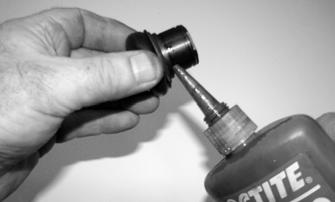
WC237
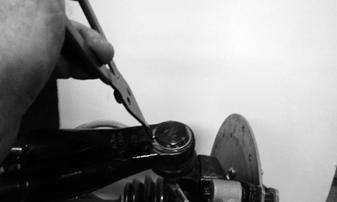
WC359
2.Install the A-arm assemblies into the frame mounts and secure with the cap screws. Only finger-tighten at this time. 3.Route the brake hose along the upper A-arm and secure with the two routing clips. 4.Secure the lower eyelet of the shock absorber to the lower A-arm. Tighten nut to 40 ft-lb (head side). 5.Secure the A-arm assemblies to the frame mounts (from step 2). Tighten the cap screws to 40 ft-lb. 6.Install the knuckle assembly onto the ball joints and secure with new “patch-lock” cap screws. Tighten to 35 ft-lb.
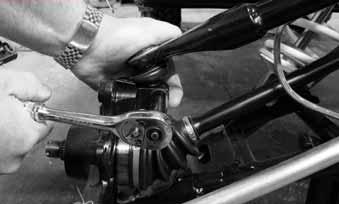
WC271
7.Install the tie rod end and secure with the nut (coated with red Loctite #271). Tighten to 55 ft-lb; then install a new cotter pin and spread the pin to secure the nut. NOTE: During assembly, new cotter pins should be
installed.
8.Apply Loctite primer and red Loctite #277 to the threads of the axle. 9.Engage the hub nut into the Belleville washer on the convex side; then with the concave side of the washer directed toward the hub, install the nut and washer.
Keeping the nut and washer engaged, tighten the hub nut to 250 ft-lb.
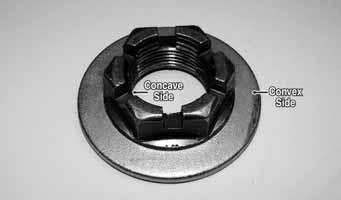
WC303A
10.Secure the brake caliper to the knuckle with two new
“patch-lock” cap screws. Tighten to 20 ft-lb.
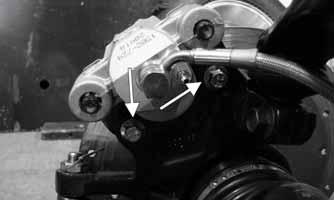
WC268A
11.Install the hub plate making sure it fits completely over the nut and lies flat against the hub.

WC317A
NOTE: If the hub plate cannot be fully installed due
to misalignment of the hub nut, tighten the nut until properly aligned and plate is fully installed.
12.Install the wheel; then using a crisscross pattern, tighten the wheel nuts in 20 ft-lb increments to a final torque factor of 80 ft-lb. Install the hub cap. 13.Remove the vehicle from the support stand.
Rear Trailing Arms
REMOVING 1.Lift and support the vehicle on support stands that allow access to the rear suspension with the rear tires off the floor. 2.Remove the hub cap and lug nuts securing the wheel; then remove the hub plate.
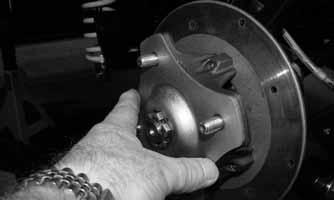
WC317
3.Place a jack stand or other support under the trailing arm; then remove the cap screw securing the lower shock eyelet to the arm. Account for a flat washer.
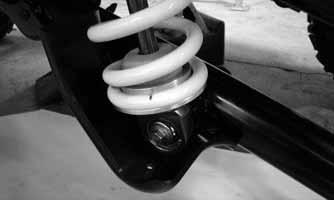
WC300
4.Remove the hub nut and Belleville washer securing the hub. 5.Remove and discard the cap screws securing the brake caliper to the knuckle and remove the caliper from the knuckle; then remove the hub/brake disc assembly.
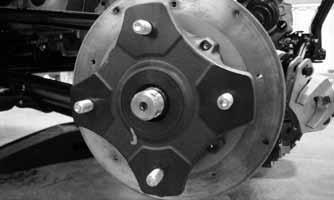
WC314
6.Remove the sway bar link; then remove the nut from the front trailing arm cross-mount through-bolt but do not remove the bolt at this time.
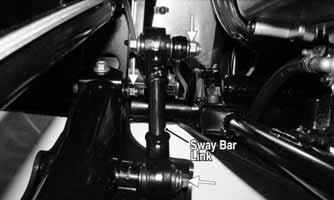
WC306A
7.Using a tarp strap or nylon straps, support the suspension/axle assembly and remove the support from under the trailing arm. 8.Drive the roll-pin out and remove the nut from the trailing arm rear knuckle pivot; then remove the forward cross-mount bolt and remove the lower trailing arm.
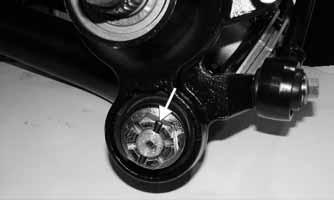
WC305A
INSPECTING 1.Inspect the arm for any signs of metal fatigue, cracked or broken welds, or severe dents or gouges. 2.Check the pivot seals and bushings for signs of dirt or water contamination and corrosion. 3.Check the knuckle pivot bushing for excessive wear. 4.Check the shock mount for wear or fatigue cracks where welded to the arm surface. INSTALLING 1.Using new seals, install the front cross-mount onto the lower trailing arm and tighten the nut to 60 ft-lb; then place the assembly into the vehicle and secure with the cross-mount through-bolt. Tighten the nut to 60 ftlb.
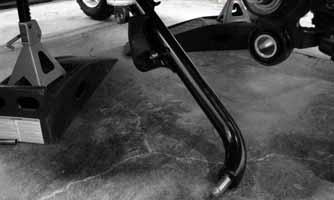
WC311
2.Slide the trailing arm into the knuckle and secure with the nut. Tighten the nut to 60 ft-lb; then install a new roll-pin.
WC305A
NOTE: If the slots in the nut do not align so as to
allow installation of the roll-pin, TIGHTEN the nut until the pin can be installed. DO NOT loosen the nut to align.
3.Place a jack stand or other suitable support under the trailing arm and install the sway bar link. Tighten the cap screw on the trailing arm and the nut on the sway bar bolt to 35 ft-lb.
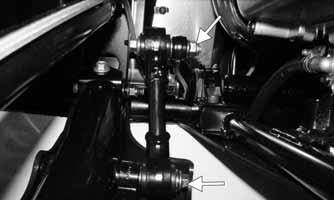
WC306B
4.Slide the shock eyelet bushing over the shock mounting boss and secure with the cap screw and washer.
Tighten to 40 ft-lb (head side). 5.Install the hub/brake disc assembly onto the axle; then apply Loctite primer and red Loctite #277 to the axle threads. 6.Engage the hub nut into the Belleville washer on the convex side; then with the concave side of the washer directed toward the hub, install the nut and washer.
Keeping the nut and washer engaged, tighten the hub nut to 250 ft-lb.
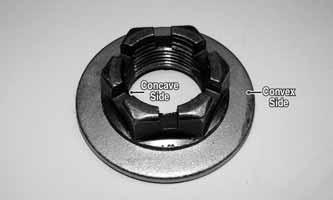
WC303A
7.Install the brake caliper and secure with new “patchlock” cap screws tightened to 20 ft-lb. 8.Install the hub plate making sure it fits completely over the nut and lies flat against the hub.

WC317A
NOTE: If the hub plate cannot be fully installed due
to misalignment of the hub nut, tighten the nut until properly aligned and plate is fully installed.
9.Install the wheel; then using a crisscross pattern, tighten the wheel nuts in 20 ft-lb increments to a final torque factor of 80 ft-lb. Install the hub cap. 10.Remove the support stands and lower to the floor.
Wheels and Tires
TIRE SIZE
! WARNING
Use only Arctic Cat approved tires when replacing tires. Failure to do so could result in unstable vehicle operation.
The Wildcat is equipped with low-pressure tubeless tires of the size and type listed in General Information. Do not under any circumstances substitute tires of a different type or size.
TIRE INFLATION PRESSURE Front and rear tire inflation pressure should be 0.84 kg/cm² (12 psi). REMOVING 1.Secure the vehicle on a support stand to elevate the wheels. 2.Remove the nuts securing the wheels; then remove the wheels. CLEANING AND INSPECTING 1.Clean the wheels and hubs with parts-cleaning solvent. 2.Clean the tires with soap and water. 3.Inspect each wheel for cracks, dents, or bends. 4.Inspect each tire for cuts, wear, missing lugs, and leaks. INSTALLING Install the wheel; then using a crisscross pattern, tighten the wheel nuts in 20 ft-lb increments to a final torque factor of 80 ft-lb. Install the hub cap. CHECKING/INFLATING 1.Using an air pressure gauge, measure the air pressure in each tire. Adjust the air pressure as necessary to meet the recommended inflation pressure. 2.Inspect the tires for damage, wear, or punctures.
! WARNING
Always use the size and type of tires specified. Always maintain proper tire inflation pressure.
! WARNING
Do not mix tire tread patterns. Use the same pattern type on front and rear. Failure to heed warning could cause poor handling qualities of the vehicle and could cause excessive drive train damage not covered by warranty.
! WARNING
Do not operate the vehicle if tire damage exists.
NOTE: If repair is needed, follow the instructions
found on the tire repair kit or remove the wheel and have it repaired professionally.
NOTE: Be sure all tires are the specified size and have
identical tread pattern.
Troubleshooting
Problem: Suspension too soft Condition Remedy
1. Spring preload incorrect 1.Adjust preload 2. Spring(s) weak 2.Replace spring(s) 3. Shock absorber damaged 3.Replace shock absorber
Problem: Suspension too stiff Condition Remedy
1. Spring preload incorrect 1.Adjust preload 2. A-arm-related bushings worn 2.Replace bushing
Problem: Suspension noisy Condition Remedy
1. Cap screws (suspension system) loose 1.Tighten cap screws 2. A-arm-related bushings worn 2.Replace bushings
Problem: Vehicle pulling or steering erratic Condition Remedy
1. Vehicle steering is erratic on dry, level surface 1.Check front wheel alignment and adjust if necessary (see Steering/Frame/Controls) 2. Vehicle pulls left or right on dry, level surface 2.Check air pressure in tires and adjust to specifications

